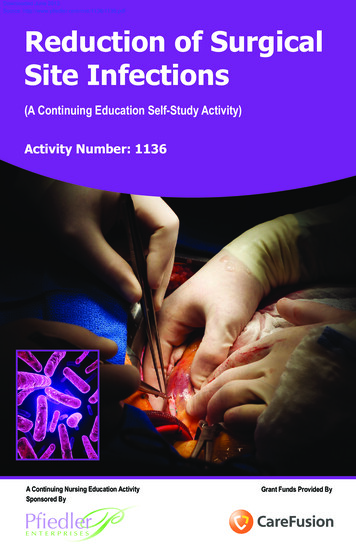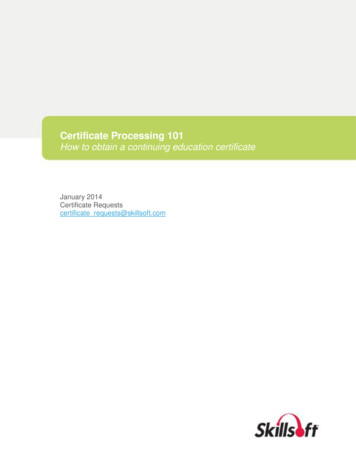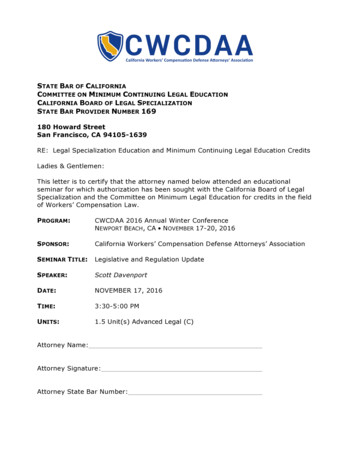
Transcription
Downloaded June 2013Source http://www.pfiedler.com/cne/1136/1136.pdfReduction of SurgicalSite Infections(A Continuing Education Self-Study Activity)Activity Number: 1136A Continuing Nursing Education ActivitySponsored ByGrant Funds Provided By
Welcome toREDUCTION OF SURGICAL SITE INFECTIONS(A Continuing Education Self-Study Activity)CONTINUING EDUCATION INSTRUCTIONSThis educational activity is intended for use as a stand alone self-study activity. Wesuggest you take the following steps for successful completion:1.Read the overview and objectives to ensure consistency with your own learningneeds and objectives.2.Review the content of the self-study activity, paying particular attention to thoseareas that reflect the objectives.3.Complete the Test Questions and compare your responses with the answersprovided.4.For additional information on an issue or topic, consult the references.5.To receive credit for this activity complete the evaluation and registration form.6.A certificate of completion will be available for you to print at the conclusion.Pfiedler Enterprises will maintain a record of your continuing education creditsand provide verification, if necessary, for 7 years.If you have any questions, please call: 720-748-6144.CONTACT INFORMATION:2101 S. Blackhawk Street, Suite 220Aurora, CO 80014-1475Phone: 720-748-6144Fax: 720-748-6196Website: www.pfiedlerenterprises.com Pfiedler Enterprises - all rights reserved 2011
REDUCTION OF SURGICAL SITE INFECTIONS(A Continuing Education Self-Study Activity)OVERVIEWThis continuing education activity focuses on the reduction of surgical site infections.Perioperative nurses continue to implement aseptic practices that result in the surgicalpatient being free of infection. This is an important patient outcome that takes constantvigil on the part of all members of the surgical team. The risks of surgical site infections areidentified and preventive strategies discussed. Background information on the significanceof the Surgical Care Improvement Project (SCIP) on the requirement of hospitals to reportsurgical core measurement data in order to receive payment from Centers for Medicare andMedicaid Services (CMS) is addressed. Antiseptic surgical skin preparation solutions thathave demonstrated efficacy in reducing surgical site infections are presented with evidencebased data. At the conclusion of this activity the perioperative nurse should be able toimplement best practices for preventing SSIs.OBJECTIVESAfter completing this continuing nursing education activity, the participant should be able to:1. Identify primary and modifiable risk factors for surgical site infections (SSIs).2. Describe evidence-based infection prevention strategies and interventions thatdecrease the risk of SSIs in hospitalized patients.3. Review results from recent clinical trials that have evaluated efficacy of antisepticsurgical skin preparation solutions.INTENDED AUDIENCEThis continuing education activity is intended for perioperative registered nurses andsurgical technologists who are interested in learning more about reducing surgical siteinfections.CREDIT/CREDIT INFORMATIONState Board Approval for NursesPfiedler Enterprises is a provider approved by the California Board of Registered Nursing,Provider Number CEP14944, for 2.0 contact hour(s).Obtaining full credit for this offering depends upon attendance, regardless of circumstances,from beginning to end. Licensees must provide their license numbers for record keepingpurposes.The certificate of course completion issued at the conclusion of this course must beretained in the participant’s records for at least four (4) years as proof of attendance.3
AST Credit for Surgical TechnologistsThis continuing education activity is approved by the Association of Surgical Technologists,Inc. for (2.0) CE credits for continuing education in surgical technology.IACET Credit for Allied Health ProfessionalsPfiedler Enterprises has been approved as an Authorized Provider by the InternationalAssociation for Continuing Education and Training (IACET), 1760 Old Meadow Road, Suite500, McLean, VA 22102.CEU STATEMENTAs an IACET Authorized Provider, Pfiedler Enterprises offers CEUs for its programs thatqualify under IACET guidelines. Pfiedler Enterprises is authorized by IACET to offer 0.2 CEU(2.0 contact hours) for this program.RELEASE AND EXPIRATION DATEThis continuing education activity was planned and provided in accordance with accreditationcriteria. This material was originally produced in June 2011 and can no longer be used afterJune 2013 without being updated; therefore, this continuing education activity expires in June2013.DISCLAIMERAccredited status as a provider refers only to continuing nursing education activities and doesnot imply endorsement of any products.SUPPORTGrant funds for the development of this activity were provided by CareFusion.PLANNING COMMITTEELouis G. Portugal, MD, FACSAssociate Professor of SurgeryChair, Surgery Quality CommitteeDirector of Quality, Perioperative ServicesUniversity of Chicago Medical CenterChicago, ILJulia A. Kneedler, RN, MS, EdDDirector of EducationPfiedler EnterprisesAurora, CO4
EXPERT REVIEWERChad Edmonson, CSTCertified Surgical TechnologistSky Ridge Medical CenterLone Tree, COJudith Pfister, RN, BSN, MBAProgram ManagerPfiedler EnterprisesAurora, COFACULTYLouis G. Portugal, MD, FACSAssociate Professor of SurgeryChair, Surgery Quality CommitteeDirector of Quality, Perioperative ServicesUniversity of Chicago Medical CenterChicago, ILDISCLOSURE INFORMATIONAll planning committee members, expert reviewers, authors and faculty participatingin continuing education activities sponsored by Pfiedler Enterprises are expected todisclose to the audience any real or apparent financial affiliations related to the content oftheir activities. Detailed disclosure appears below and also will be made verbally prior tothose activities with live presentations.Planning committee members, expert reviewers, authors and faculty information:1. Have you (or your spouse/partner) had any personal financial relationship inthe last 12 months with the manufacturer of the products or services that willbe presented in this continuing education activity (planner/reviewer) or in yourpresentation (speaker/author)?2. Type of affiliation/financial interest with name of corporate organization.3. Will your presentation include discussion of any off-label or investigational drug ormedical device?Louis G. Portugal, MD, FACS1. Yes2. Consultant to funds provider.3. NoChad Edmonson, CST1. No2. None3. No5
Julia A. Kneedler, RN, MS, EdD1. Yes2. Employed by company that receives funds from CareFusion.3. NoJudith Pfister, RN, BSN, MBA1. Yes2. Employed by company that receives funds from CareFusion.3. NoPRIVACY AND CONFIDENTIALITY POLICYPfiedler Enterprises is committed to protecting your privacy and following industry bestpractices and regulations regarding continuing education. The information we collectis never shared with other organizations for commercial purposes. Our privacy andconfidentiality policy covers the site www.pfiedlerenterprises.com and is effective onMarch 27, 2008.To directly access more information on our Privacy and Confidentiality Policy, typethe following URL address into your browse: df or View the Privacy and Confidentiality Policy using the followinglink: tm. In addition to this privacystatement, this website is compliant with the guidelines for internet-based continuingeducation programs.The privacy policy of this website is strictly enforced.CONTACT INFORMATIONIf site users have any questions or suggestions regarding our privacy policy, pleasecontact us es.comPostal Address:2101 S. Blackhawk Street, Suite 220Aurora, Colorado 80014Website URL:http://www.pfiedlerenterprises.com6
INTRODUCTIONOf the more than 30 million surgeries performed in the United States each year, surgicalsite infections (SSIs) are associated with approximately 500,000 procedures. The averageSSI adds 7 to 10 days on to the length of the hospital stay and attributable costs for justone case can range from 12,488 to 36,462. Patients with SSIs experience a longertime to recovery, more pain, and a higher likelihood of developing additional complicationscompared to patients who do not acquire an infection. Moreover, the risk of death for thoseaffected by SSIs is 2 to 11 times greater than non-infected surgery patients.SSI RISK FACTORS AND RISK REDUCTIONMost infections are caused by endogenous factors, such as pathogens that inhabit thepatient’s skin. Staphylococcus aureus is the most frequently found microorganism on theskin and the most common isolate associated with the development of SSIs. Exogenoussources of microorganisms that contribute to SSIs include transient flora from the surgicalteam members’ hands, fingernails, forearms, and jewelry that are transferred to patients.Likewise, instruments, tools, and other materials used in the operating room may becontaminated with bacteria if not properly sterilized.SSI: Primary Risk FactorsFigure 1. SSI: Primary Risk Factors Endogenous microorganisms– Skin-dwelling microorganisms S. aureusMost common sourceS. aureus most common isolate Exogenous microorganisms– Surgical personnel– OR environment– All tools, instruments, and materialsReference: Mangram AJ, et al. Infect Control Hosp Epidemiol. 1999;20(4):250-78Considering the high rate of morbidity and mortality associated with SSIs, infectionprevention is a top priority necessary to improve patient safety. While not all bacterialMangram AJ, et al. Infect Control Hosp Epidemiol.1999;20(4):250-78.infectionscan be prevented, research suggests a significant number can be avoided by the page 5use of assiduous evidence-based infection control measures. Thus, a number of preventionstrategies are recommended by the Centers for Disease Control and Prevention (CDC)and the Healthcare Infection Control Practices Advisory Committee (HICPAC) to reducesurgical site morbidity. These recommendations include:¾¾ Ensuring tight glucose control in diabetic patients.¾¾ Having the patient shower with an antiseptic before surgery to reduce bacterialload.¾¾ Leaving hair intact or, if necessary, removing hair with clippers.¾¾ Encouraging the surgical team to practice proper hand and forearm antisepsis toprevent exogenous contamination.7
¾¾ Treating the surgical site with an antiseptic skin preparation before surgery.¾¾ Initiating a prophylactic antibiotic immediately prior to surgery to reduce microbial burden.¾¾ Ensuring normal body temperature intraoperatively. Hypothermia can cause vesselconstriction, which decreases oxygen levels at the surgical site, lowers immunity, andimpedes wound healing.The consistent use of CDC evidence-based strategies has been demonstrated by multiplestudies to be associated with lower SSI-related morbidity and mortality. However, successfulinfection prevention requires a consistent team approach within each facility to ensure that bestpractices are implemented. This means everyone involved in the surgery, including the patient,must work together to reduce the risk of SSI.THE SURGICAL CARE IMPROVEMENT PROJECT (SCIP)SCIP is a national quality partnership of organizations with a common goal to improve patientcare by significantly reducing the incidence of surgical complications. SCIP specificationsare part of the National Hospital Quality Inpatient Measures of the Centers for Medicare andMedicaid Services (CMS) and The Joint Commission. Because SCIP reporting is a CMS pay-forperformance initiative, hospitals are required to document and publically report specific surgicalcore measurement data in order to receive full annual payment.Surgical Care Improvement Project(SCIP) SCIP initiative is part of a national campaign to reducesurgical complications 25% by 2010 Includes the assessment of performance and processmeasures to reduce SSIs CMS has identified specific measures that hospitals arerequired to report publicly in order to receive full annualpaymentOf the modifiable risk factors for SSIs addressed by the CDC guidelines, antibiotic prophylaxis,glucose control, and appropriate hair removal are specifically cited in SCIP as target areas thathelp reduce the incidence of infection and improve patient care.IHI. Available at: alSiteInfections/. page 88
Table 1. SCIP c(4)SCIP-Inf 1:Prophylactic antibiotic received within one hour prior to surgicalincisionSCIP-Inf 2:Prophylactic antibiotic selection for surgical patientsSCIP-Inf 3:Prophylactic antibiotics discontinued within 24 hour aftersurgery end time (48 hours for cardiac patients)SCIP-Inf 4:Cardiac surgery patients with controlled 6 a.m. postoperativeserum glucose (#200 mg/dL)SCIP-Inf 5:Postoperative wound infection diagnosed during indexhospitalizationSCIP-Inf 6:Surgical patients with appropriate hair removalSCIP-Inf 7:Colorectal surgical patients with immediate postoperativenormothermiaSCIP-Card 1:Non-cardiac vascular surgery patients with evidence of coronarydisease who received beta-blockers during perioperative periodSCIP-Card 2:Surgical patients on a beta-blockerSCIP-Card 3:Intra- or postoperative acute myocardial infarction (AMI)diagnosed during index hospitalization and within 30 days ofsurgerySCIP-VTE 1:Surgical patients with recommended venous thromboembolismprophylaxis orderedSCIP-VTE 2:Surgery patient who received appropriate venousthromboembolism prophylaxis within 24 hours prior to surgeryto 24 hours after surgerySCIP-VTE 3:Intr- and postoperative pulmonary embolism (PE) diagnosedduring index hospitalization and with 30 days of surgerySCIP-VTE 4:Intra- and postoperative deep vein thrombosis (DVT) diagnosedduring index hospitalization and within 30 days of surgeryThe Surgical Care Improvement Project (SCIP). Available at:www.qualitynet.org/dcs/ContentServer?c MQParents&pagename Medqic/Content/ParentShellTemplate&cid 1122904930422&parentName Topic.9
MODIFIABLE RISK FACTORS: SURGICAL SITE AND SKINPREPARATIONAntibiotic ProphylaxisA brief course of an appropriately administered antibiotic prior to surgery reducesbacterial burden and lowers risk of SSI. The CDC recommends adhering to severalprinciples in order to maximize the prophylactic effect of the antibiotic:¾¾ Choose an appropriate antimicrobial agent that will combat the intraoperativepathogens most likely to be associated with the particular surgical procedure.¾¾ Administer a proper dose based on weight/BMI and renal function 1 hour beforesurgery. Evidence indicates that lower rates of SSIs occur when prophylacticantibiotics are appropriately selected and administered prior to the surgicalincision. Most of the appropriate antibiotics should be infused no more than 60minutes prior to surgery. The longer the duration of time of dose administrationprior to surgery, the greater risk of SSI development. Vancomycin is an exceptionas it can be infused 1-2 hours before the incision.¾¾ Re-dose for prolonged procedures.¾¾ Discontinue antibiotic use within 24 hours of surgery.Hair RemovalPreoperative shaving of the surgical site is associated with a significantly higher riskof infection than removing hair by depilatory products or by clippers. Shaving createsmicroscopic abrasions on the skin, which allow an entryway for pathogens. Some studieshave reported a higher rate of SSIs related to hair removal by any means. Therefore,CDC guidelines recommend not removing hair prior to an operation unless it is at oraround the incision site and will interfere with the procedure. Furthermore, if hair must beremoved, it should be clipped immediately before surgery with clippers.Hair Removal: Clippers vs RazorFigure 2. Hair Removal: Clippers vs. RazorBefore ClippingBefore ShavingAfter ClippingAfter Shaving page 12
Recent EvidenceFigure 3. Recent Evidence 39-month study on 1827CABG procedures– Patient care pathway– Included switch fromshaving to clipping, timelyantibiotic administration,and tighter blood glucosecontrolP .001 Sternal infections fell from3.5% to 1.5%Reference: Trussell J, et. al. Am J Surg. 2008;196:883-9GlucoseControlTrussell J, et al. Am J Surg. 2008;196:883-9.Hyperglycemia leads to lower levels of oxygen and compromised blood perfusion in diabetic page 13patients, which consequently slows wound healing and increases infection risk. However,maintaining perioperative blood glucose control has been found to reduce incidence of SSIs.For example, results of one study that evaluated 2467 diabetic patients who underwent openheart surgery found that keeping blood glucose levels less than 200 mg/dL via continuousinsulin infusion during surgery significantly decreased the incidence of serious SSIs.OTHER MODIFIABLE RISK FACTORS: SURGICAL SITE AND SKINPREPARATIONPreparing the patient’s skin at the site at which surgery will be performed is essential toreduce microflora and decrease risk of postoperative infection. The prepared area should belarge enough to accommodate an extension of the incision and additional drainage sites.The most commonly used skin preparation antiseptics are chlorhexidine gluconate,iodophors, such as povidone-iodine, and alcohol-containing products.Antiseptic Surgical Skin Preparation SolutionsAlcohol is an inexpensive and rapid-acting germicide that has a broad spectrum of activityagainst gram-positive and gram-negative bacteria, fungi and viruses. However, the agenthas a number of disadvantages to its use as a skin preparation, including a short durationof action, no residual activity, inactivity when exposed to blood or organic materials, minimalto no effect against spores, and it promotes dry skin. In addition, alcohol cannot be used onmucosal membranes.Iodine/iodophors, like alcohol, kill most gram-positive and gram-negative pathogens, fungi,and viruses, and have some activity against spores. Despite their antiseptic ability, iodophorsneutralize rapidly in the presence of organic material (such as blood and serum proteins),vary in persistence, and irritate the skin.
Chlorhexidine is a highly potent and persistent antiseptic that works against gram-positiveand gram-negative pathogens, fungi, and viruses, but does not have activity against spores.It remains active in the presence of organic material, is minimally absorbed, and does notcause skin irritation. Furthermore, chlorhexidine has been proven to be highly efficacious atreducing microbial load in numerous studies evaluating hand hygiene practices, IV cathetercare, preoperative showers and baths, and skin preparation prior to surgery.Chlorhexidine in the ICUMultiple clinical trials have demonstrated the efficacy of chlorhexidine in reducing bacterialcolony counts in individuals admitted to the ICU. In one 15-month study conductedin an Illinois teaching hospital, 1787 ICU patients were bathed or cleansed daily witheither non-medicated cloths, soap and water-soaked cloths, or cloths saturated with 2%chlorhexidine, and then evaluated for acquisition of vancomycin-resistant Enterococci (VRE).Compared to non-medicated or soap and water baths, cleansing with chlorhexidine clothsproduced significantly less VRE contamination on patients’ skin, ICU workers’ hands, andenvironmental surfaces.In another recent study, ICU patients who also received daily baths with chlorhexidine weresignificantly less likely (61%) to acquire a primary blood stream infection (BSIs) or catheterassociated BSI compared to subjects who were bathed in soap and water.Skin Preps: ComparisonTable 2. Skin Preps: ComparisonActive AgentsBroad SpectrumTraditionalIodophorsAlcoholCHGXXXRapid ActivityXResidual ActivityXActivity in Blood/OrganicXNon-IrritatingXReferences: Larson EL. Am J Infect Control. 1995;23(4):251-69.Boyce JM, et al. MMWR Recomm Rep. 2002;51(RR-16);1-45.Preoperative ShowersLarson EL. Am J Infect Control. 1995;23(4):251-69.Hidalgo E, et al. Toxicol In Vitro. 2001;15(4-5):271-6.Maki DG, et al. Lancet. 1991;338:339-43.Larson E, et al. Am J Infect Control.1992;20(2):65-72.Boyce JM, et al. MMWR Recomm Rep. 2002;51(RR-16):1-45.Anders N, et al. J Cataract Refract Surg. 1997;23(6):959-62.Perez R, et al. Laryngoscope. 2000;110(9):1522-7.Prior to surgery, the CDC recommends that patients take an antiseptic shower to decreaseskin microbial density. The 2 most common antiseptic agents used for preoperative showers page 20and baths are chlorhexidine gluconate and povidone-iodine. Although both drugs havebroad-spectrum activity against numerous microorganisms, the CDC guidelines stated thatshowering with chlorhexidine prior to surgery has been demonstrated to reduce skin bacterialcolony count significantly more than a shower with povidone-iodine (9-fold vs 1.3-fold,respectively).12
EFFICACY OF ANTISEPTIC SURGICAL SKIN PREPARATIONSOLUTIONS: RECENT STUDIESDue to the unique anatomy of the foot, successful elimination of bacteria on the skinaround and in between the toes prior surgery is challenging. Consequently, woundcontamination and higher SSI rates have been reported in foot and ankle procedurescompared to other types of surgery.One recent study assessed the effectiveness of 3 skin antiseptic preparation solutionsin eliminating bacteria from the foot preoperatively. Before incision, patients wererandomized to be cleansed with either chlorhexidine/isopropyl alcohol (IPA), iodine/IPA,or chloroxylenol. After skin preparation, cultures of bacteria were obtained from the halluxnail fold, between the toes, and from the anterior tibia (control site). Results revealedthat overall, chlorhexidine/IPA was the most effective antiseptic skin prep among the 3study agents. Compared to iodine/isopropyl alcohol and chloroxylenol, chlorhexidine/IPAsignificantly reduced bacteria colony counts of the halluces and toes.In another recent study, chlorhexidine/isopropyl alcohol was more effective than iodine/isopropyl or povidone-iodine in eliminating overall bacteria from the shoulder region of150 surgery patients. Significantly lower positive culture rates of coagulase-negativeStaphylococcus and Propionibacterium acnes were found in the chlorhexidine/IPA groupversus the other 2 skin prep cohorts.While these studies and numerous others have established chlorhexidine as a potentantiseptic that provides meaningful reductions in skin bacterial colony counts in manydifferent types of surgery, until recently there was no definitive proof that the agentlowered SSI rates. However, a recently published trial of 897 patients undergoing cleancontaminated surgery demonstrated that chlorhexidine-alcohol scrub was significantlymore effective than povidone–iodine scrub for the prevention of SSIs. In this multiinstitutional prospective study, subjects were randomized to be prepped with eitherchlorhexidine and alcohol scrub or a povidone-iodine skin scrub and paint. All patientswere similar with respect to demographics, other medical conditions, individual risk forinfection, and length and type of surgery.The investigators followed the subjects for 30 days after surgery to identify the incidenceof any SSI. Results revealed a significant 41% reduction in overall SSI rate in those whowere prepped with chlorhexidine-alcohol versus individuals who received povidoneiodine prep (9.5% vs 16.1%; P 0.004, respectively). Chlorhexidine–alcohol was alsosignificantly more effective than povidone–iodine in preventing both superficial incisionalinfections (4.2% vs 8.6%, P 0.008) and deep incisional infections (1% vs 3%, P 0.05).However, there were no notable differences between the 2 cohorts in the rate of organspace infections or sepsis due to SSI. Additionally, the occurrence of adverse events wassimilar in both groups.13
to Type of InfectionTable 3. Proportion of Patients with Surgical-Site Infection, According to Type ofInfection (Intention-to-Treat Population).Proportion of Patients with SSI, Accordingto Typeofet al.Surgery(ITT)Reference:Darouiche RO,N Engl J Med. 2010;362:18-26.Darouiche RO, et al. N Engl J Med. 2010;362:18-26.Table4. Proportion of Patients with SSI, According to Type of Surgery (ITT). page 32Reference: Darouiche RO, et al. N Engl J Med. 2010;362:18-26.Darouicheet al. N Engl J Med.2010;362:18-26.Figure4. RO,Standardsof Pre-OperativeSkin Prep.Standardsof Pre-OperativeSkin Prep Use a combination of a rapid-acting agent (alcohol) anda longer lasting agent (chlorhexidine) Greater activity of chlorhexidine compared toiodine/iodophors– Both in the laboratory and on patient’s skin Continued antimicrobial activity of chlorhexidine inpresence of blood and serum– Iodine/iodophors become inactivated in the presence of thesefluids Accumulative benefit of chlorhexidine when repeatedlyapplied 50% reduction in intravascular catheter-related infectionswhen chlorhexidine is used as skin prepMilstone AM, et al. Clin Infect Dis. 2008;46:274–81.Reference: Milstone AM, et al. Clin Infect Dis. 2008;46:274-81.14 page 36 page 33
CONCLUSIONSSIs are common and costly complications that increase morbidity and mortality inhospitalized patients. While not all SSIs can be prevented, research has establishedthat a significant portion can be avoided by following evidence-based infection controlprinciples, such as tight glucose control in diabetic patients, timely prophylactic antibioticadministration, appropriate hair removal, and aseptic skin and surgical site preparation.However, in order for prevention strategies to be successful, a team approach withineach facility is necessary to ensure that best practices are implemented consistently.15
GLOSSARYCohortTo place two or more residents colonized orinfected with the same pathogen in the sameliving quarters.EndogenousProduced within or caused by factors within theorganism.ExogenousOriginating outside or caused by factors outsideof the organism.Healthcare-Associated Infection(HAI)An infection acquired by patients duringhospitalization, with confirmation of diagnosis byclinical or laboratory evidence.Multi-Drug Resistant Organisms(MDRO)Bacteria, viruses and other microorganisms thathave developed resistance to antimicrobial drugs.Surgical Site Infection (SSI)An infection occurring at the site of a surgicalincision within the first 30 days after surgeryor the first year after a procedure involving animplantable device.16
ABBREVIATIONS AND ACRONYMSAMIAcute myocardial infarction.BMI Body mass index.BSIBlood stream infection.CABG Coronary artery bypass graft.CDC Centers for Disease Control and Prevention.CMS Centers for Medicare and Medicaid Services.CHG Chlorhexidine gluconate.CPI Consumer Price Index.CVC Central venous catheter.CLABSICentral line-associated bloodstream infection.DVTDeep vein thrombosis.HAI Healthcare-associated infection.HICPACHealthcare Infection Control PracticesAdvisory Committee.IPAIsopropyl ular.ICU Intensive care unit.MRSA Methicillin-resistant Staphylococcus aureus.PE Pulmonary embolism.PI Povidone-iodine.17
S. aureus Staphylococcus aureus.SCIP Surgical Care Improvement Project.SSI Surgical site infection.VRE Vancomycin-resistant Enterococcus.VTE Venous thromboembolism.18
REFERENCES/SUGGESTED READINGSAnders N, Wollensak J. Inadvertent use of chlorhexidine instead of balanced salt solution forintraocular irrigation. J Cataract Refract Surg.1997;23(6):959-62.Anderson DJ, Kaye KS, Classen D, et al. Strategies to prevent surgical site infections inacute care hospitals. Infect Control Hosp Epidemiol. 2008;29(suppl 1):S51-S61.Bleasdale SC, Trick WE, Gonzalez IM, et al. Effectiveness of chlorhexidine bathing toreduce catheter-associated bloodstream infections in medical intensive care unitpatients. Arch Intern Med. 2007;167(19):2073-9.Boyce JM, Pittet D; Healthcare Infection Control Practices Advisory Committee; HICPAC/SHEA/APIC/IDSA Hand Hygiene Task Force. Guideline for Hand Hygiene in HealthCare Settings. Recommendations of the Healthcare Infection Control PracticesAdvisory Committee and the HICPAC/SHEA/APIC/IDSA Hand Hygiene Task Force.Society for Healthcare Epidemiology of America/Association for Professionals inInfection Control/Infectious Diseases Society of America. MMWR Recomm Rep.2002;51(RR-16):1-45.Darouiche RO, Wall MJ Jr, Itani KMF, et al. Chlorhexidine-alcohol versus povidone-iodine forsurgical-site antisepsis. N Engl J Med. 2010;362:18-26.Garibaldi RA. Prevention of intraoperative wound contamination with chlorhexidine showerand scrub. J Hosp Infect.1988;11(suppl B):5-9.Hidalgo E, Dominguez C. Mechanisms underlying chlorhexidine-induced cytotoxicity. ToxicolIn Vitro. 2001;15(4-5):271-6.The Institute for Healthcare Improvement. Surgical Site Infections. Available at: alSiteInfections/. Accessed February 15, 2011.Kelly R, Usry G, Blackhurst D, et al. Prevention of infections related to central venouscatheters and arterial catheters in intensive care patients: a prospective randomizedtrial of chlorhexidine gluconate (CHG) versus povidone iodine (PI). 15th AnnualScientific Meeting of the Society for Healthcare Epidemiology of America; April 9-12,2005; Los Angeles, CA. Abstract 165.Larson EL. APIC guideline for handwashing and hand antisepsis in health care settings. AmJ Infect Control.1995;23(4):251-69.Larson EL, McGinley KJ, Foglia A, et al. Handwashing practices and resistance anddensity of bacterial hand flora on two pediatric units in Lima, Peru. Am J InfectControl.1992;20(2):65-72.Maki DG, Ringer M, Alvarado CJ. Prospective randomised trial of povidone-iodine, alcohol,and chlorhexidine for prevention of infection associated with central venous andarterial catheters. Lancet.1991;338:339-43.19
Mangram AJ, Horan TC, Pearson ML, et al. Guideline for prevention
Inc. for (2.0) CE credits for continuing education in surgical technology. IACET Credit for Allied Health Professionals. Pfiedler Enterprises has been approved as an Authorized Provider by the International Association for Continuing Education and Training (IACET), 1760 Old Meadow Road, Suite 500, McLean, VA 22102. CEU STATEMENT










